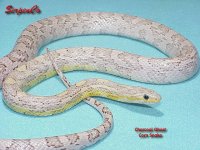From my retired SerpenCo.com website.
Charcoal Ghost Corn Snake
This cultivar is a project I started a few years ago and seemed like a natural thing to do with the Charcoal gene. Ghosts based on the 'A' anerythrism gene have been popular and pleasing looking animals, so there was no reason to doubt that Charcoal Ghosts would be any less and possibly much more so. But what a puzzle they have produced! I have been producing them for a few years now and there is so much variation in the offspring that it has had me rethinking what the Charcoal gene really is. I've gotten some offspring with so much yellow to them that I have to suspect that the axanthism (partially or complete) that we see in the typical Charcoal is not at tied with the actual Charcoal look. So of the Charcoal Ghosts can look like fairly typical 'A' anerythrism based Ghosts whereas others can look like nothing I've ever imagined before out of this project. The one I have used in the photo to represent this cultivar is an astounding animal that is a lavender gray with lemon yellow highlights on the sides of the head and neck. Further, this yellow coloration extends on the dorsal area of the body and extends fully a third of the body length. And since this is a comparative youngster I am REALLY anticipating seeing what it looks like when it reaches full adulthood.
Of course, not all of the Charcoal Ghosts are going to be like the one I have indicated above, and many appear to be more typical of what I had expected out of this project. The yellow coloration (Xanthism) appears to be a wild card for now, and as it seems to be an influence that doesn't show up until a handfull of shed skins have taken place, there is going to be a bit of pot luck involved in how any given individual will turn out as it matures. But this is more the rule than the exception when you are working with corn snakes.
Naturally enough, I am not expecting to sell very many of these this year. Many will probably get marked with the dreaded 'keeper' tag since this is still a project in it's infancy around here. I have become so enthusiastic about this cultivar that I have begun a few more lines using different flavors of Hypomelanism to see what will result.

